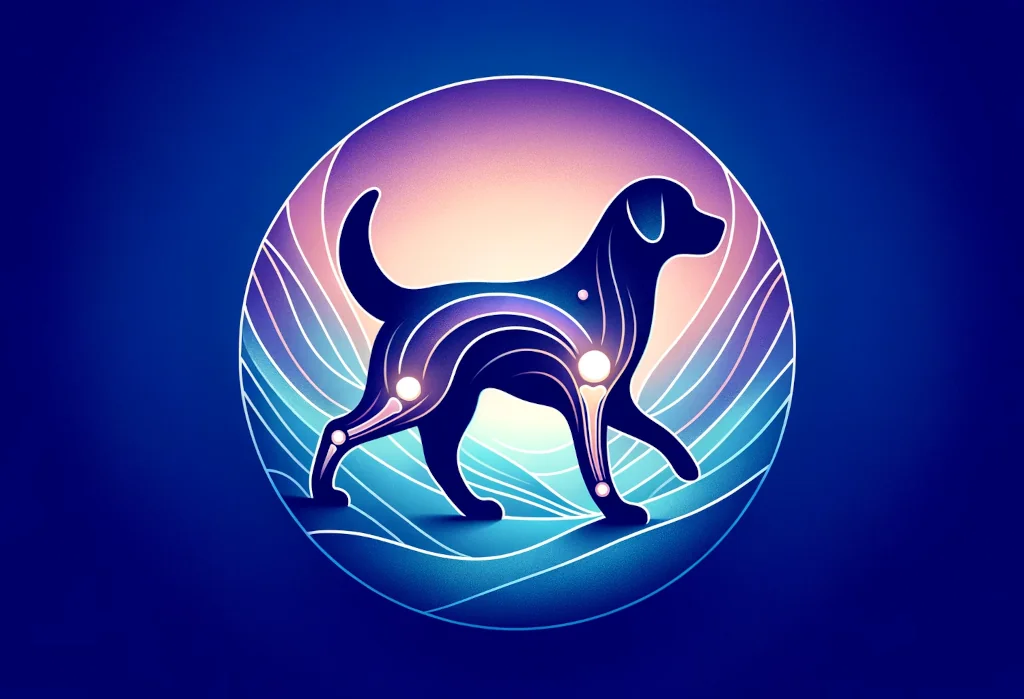Watching your furry best friend slow down and struggle with the aches and pains of osteoarthritis can be heart-wrenching. It’s like they’ve lost their mojo, and you’d do just about anything to get that tail wagging happily again. In this blog post, you’ll find compassionate, effective strategies to revitalize your dog’s zest for life, despite osteoarthritis.
We’re here to guide you through easing their discomfort and enhancing their well-being – one paw at a time.

Quick Takeaways:
- Check for stiffness, limping, or reduced activity in your dog as early signs of osteoarthritis and consult your vet for a precise diagnosis.
- Maintain your dog’s joint health with gentle exercises like swimming, a balanced diet, and supplements such as omega-3 fatty acids and glucosamine.
- Use orthopedic beds, ramps, and elevate eating stations to ease daily discomfort and support your dog’s mobility and comfort at home.
What exactly is osteoarthritis in dogs?
Osteoarthritis, also known as degenerative joint disease, is the elephant in the room for many aging dogs, quietly sneaking up before making its presence unavoidably known. In essence, it’s a chronic condition characterized by the deterioration of cartilage in the joints, leading to pain, stiffness, and reduced mobility.
While it’s more common in older dogs, don’t be fooled into thinking it’s just an “old dog” problem. Overweight dogs or those with previous joint injuries are also at high risk, making it a concern for a broader demographic of our canine companions. Understanding this condition is the first step in effectively managing it, ensuring your furry friend can lead a happier, more comfortable life.
How can you tell if your dog has osteoarthritis?
Now, onto decoding your dog’s silent messages. Osteoarthritis is a sneaky adversary, often creeping in without a loud announcement. Keep an eye out for these tell-tale signs:
- Stiffness: Does your pup seem more like a rusty robot than a lively dog first thing in the morning or after a nap? This could be more than just grogginess.
- Limping: If your dog starts favoring one leg, or if the limp comes and goes, don’t chalk it up to a simple sprain too quickly.
- Difficulty standing up: Those cute grunts might not just be your dog telling you they’re old; getting up from a lying or sitting position may genuinely be a challenge.
- Reduced activity levels: Less enthusiasm for walks or playtime isn’t necessarily a sign of laziness. It might be their way of saying, “It hurts to move.”
Paying close attention to these symptoms can help you catch osteoarthritis early, potentially slowing its progression and improving your dog’s quality of life.
What can you do at home to ease your dog’s osteoarthritis pain?
Watching your dog struggle with osteoarthritis can be heart-wrenching, but there’s a lot you can do to turn their frown upside down. Here’s how you can be your dog’s superhero from the comfort of your home:
-
Orthopedic Beds: Provide a high-quality orthopedic bed that supports their joints and makes getting up a tad easier. Think of it as their personal cloud.
-
Ramps and Stairs: Life doesn’t have to be an uphill battle for your pooch. Use ramps or pet stairs to make climbing into bed or the car less daunting.
-
Keep’em Warm and Cozy: Joint stiffness can worsen in the cold, so ensure their sleeping area is warm and draft-free. A heated dog bed or blanket can work wonders.
-
Gentle Exercise: Regular, low-impact exercise helps keep the joints supple and maintains muscle strength. Think leisurely walks or a gentle game of fetch, not the Doggy Olympics.
-
Weight Management: Keeping your dog at a healthy weight reduces the strain on their joints. This might mean adjusting their diet with the help of your vet.
-
Massage and Physical Therapy: Gentle massage can help increase circulation and alleviate pain. There are also canine physical therapists trained to work wonders on sore joints.
Now, here’s a nugget of wisdom that’s often overlooked: personalized eating stations. Dogs with osteoarthritis struggle to reach down and eat from traditional bowls on the floor. Elevating their food and water bowls can make mealtime a pain-free experience. It’s a simple tweak, but it shows your dog that you’re in tune with their needs.
There you have it — practical steps to give your dog a more comfortable and joyous life, despite the challenges of osteoarthritis. Remember, these tips are not the end-all solution; regular veterinary care is crucial to manage this condition effectively.
Are There Specific Exercises That Help Dogs With Osteoarthritis?
When your furry companion is suffering from osteoarthritis, you might mistakenly think that rest is the key. However, staying active is crucial for managing this condition effectively. Gentle, low-impact exercises can work wonders for your dog, enhancing joint mobility and keeping those muscles strong. It’s about finding the right balance – enough to keep them moving but not too much that it exacerbates the pain.
So, what exercises tick these boxes? Swimming is a top-tier option; it’s the poster child for low-impact exercises. The water supports your dog’s body, reducing strain on the joints, allowing for freedom of movement without the weight. Then there are slow, short walks. These are not about the distance covered but the quality of movement, maintaining muscle strength and joint flexibility without overdoing it.
Key Points to Remember:
- Balance is Essential: Keep the exercise routine well-balanced between rest and activity.
- Tailor the Plan: Consult with your vet to tailor an exercise plan that fits your dog’s specific condition and needs.
- Monitor and Adapt: Pay close attention to how your dog reacts to the exercise routine and be ready to adapt as necessary.
Remember, every dog is unique, and what works for one may not suit another. It’s always safest to consult with your vet to craft the perfect exercise blend for your buddy.
What About Diet and Supplements?
Osteoarthritis management isn’t just about physical activity; it extends to what our dogs eat. A balanced diet paired with specific nutritional supplements can greatly influence their comfort and mobility. Here’s the lowdown on diet and supplements for dogs with osteoarthritis:
-
Balanced Diet : Focus on maintaining a healthy weight to reduce pressure on the joints. Your vet can help design a diet plan that meets your dog’s nutritional needs while controlling their weight.
-
Omega-3 Fatty Acids : Known for their anti-inflammatory properties, omega-3 fatty acids can help lessen joint pain and inflammation. Foods rich in omega-3s include fish oil supplements or diets formulated with flaxseed oil.
-
Glucosamine and Chondroitin : These supplements are hailed for their ability to support joint health, potentially helping to repair and rebuild cartilage. Integrating glucosamine and chondroitin supplements into your dog’s diet can make a sizable difference in their mobility and comfort.
-
Unique Tip : Consider incorporating green-lipped mussel (GLM) into your dog’s diet. This is not as widely discussed but GLM is rich in omega-3s and other compounds that support joint health, making it a double whammy for combating osteoarthritis symptoms.
Remember to always discuss any dietary changes or supplements with your vet to ensure they’re appropriate for your dog’s specific health needs.
When Should You See a Vet?
Navigating the journey of osteoarthritis in dogs is not a solo mission. Your veterinarian is an indispensable partner in managing your dog’s condition. Here are the key times when you should certainly reach out to them:
-
Initial Diagnosis : If you suspect your dog is showing signs of osteoarthritis, it’s time to consult your vet. They can perform a thorough examination, possibly include imaging tests, to confirm the diagnosis.
-
Personalized Treatment Plans : Each dog’s battle with osteoarthritis is unique. Your vet can develop a treatment plan tailored to your dog’s specific needs, encompassing everything from exercise regimens to medication.
-
Adjusting Pain Management : Osteoarthritis is a progressive condition, meaning your dog’s pain management needs may change over time. If you notice any changes in their mobility or behavior, it could be time to reassess their pain management plan.
-
Regular Check-Ups : Don’t wait for an issue to arise. Regular check-ups are essential for monitoring the condition and making necessary adjustments to the management plan.
Remember, early intervention and consistent management can dramatically improve the quality of life for dogs with osteoarthritis. Your vet is your co-pilot in ensuring your dog remains comfortable, happy, and as active as possible.
In wrapping up, managing osteoarthritis in dogs is a multifaceted journey – one that encompasses gentle exercise, nutritional support, and an open, ongoing dialogue with your veterinarian. It’s about creating a tailored approach that meets your dog’s individual needs, helping them maintain an excellent quality of life, despite their diagnosis.
Alex, a passionate animal lover, has experience in training and understanding animal behavior. As a proud pet parent to two dogs and three cats, he founded AnimalReport.net to share insights from animal experts and expand his knowledge of the animal kingdom.




